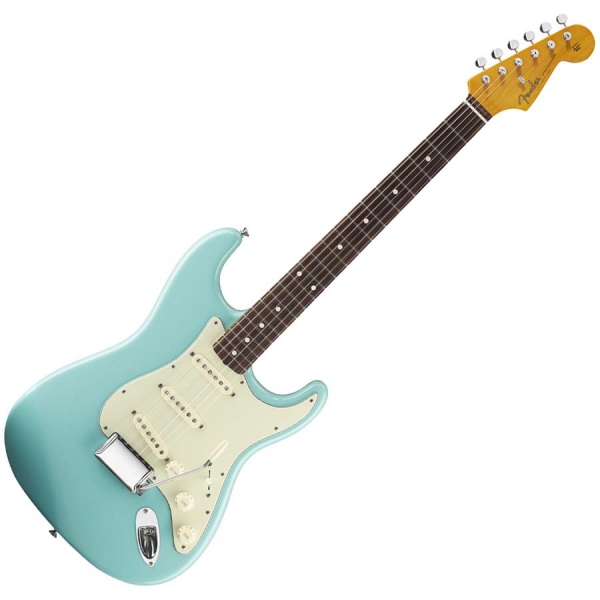In addition to all of the guitar related stuff I’ve collected over the years, I’ve gone through a variety of recording gear that I’ve used to make my music.
Much of that older stuff is long gone, like my Boss BR-8, a digital 8 track recorder I used in the early 2000s, and my old Fender Cyber Deluxe amp, which had an amp simulation output jack that allowed me to go direct from the amp into my audio interface.
I also had a rack mount Focusrite TrakMaster Pro preamp channel strip, which had a built-in compressor and a mid-scoop EQ to filter out the boomy sounds from my guitars and my Billy Idol/Johnny Cash baritone voice box.
I still have a few of the older things kicking around, but for the most part, my basic recording setup is quite modern, with 4/5 of it being gear that was purchased within the past few years. Three of these five items were bought within the past three months.
As with any craft, the tools you use to make your art/product are constantly evolving with the times, and with your specific needs, wants and budget. I’ve used many different cameras and lenses over the years; music gear is kind of the same.
So, with that in mind, here are the five essential pieces of gear I use in my recording and music production workflow right now.
1. IK Multimedia AXE I/O Solo
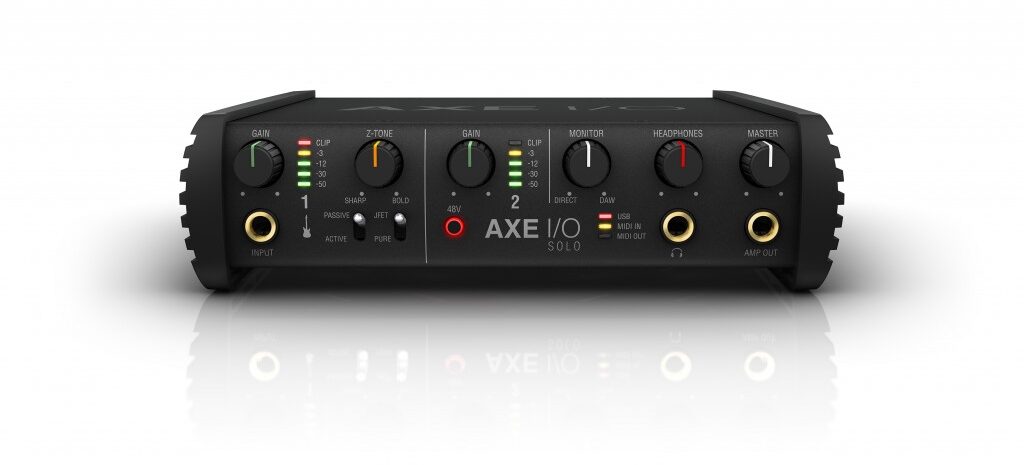
As a recording guitarist, my number one concern is getting kick ass guitar sounds into the computer. I’ve gone through a number of solutions over the years, but by far, the best option I’ve ever tried is the AXE I/O Solo by IK Multimedia.
The AXE I/O is premium audio interface that’s specifically geared for guitarists. It has two inputs, one for guitar and one for an XLR mic, a Class A preamp and excellent analog to digital converters that produce incredible, 24 bit, 192 kHz high quality sound.
In addition, the AXE I/O has some incredible tone-shaping technology that helps you coax a wide range of sounds from your guitar or bass. One switch lets you choose between passive or active pickups, and a second switch lets you choose either a pure, completely transparent preamp circuit, or one that adds a JEFT input buffer for increased harmonic enhancement and midrange warmth.
It also features IK’s Z-TONE circuit knob, which lets you adjust the impedance of your signal, resulting in a sharper, tighter sound, or a thicker, warmer tone. Finally, the unit has a dedicated Amp-Out jack that allows you to feed an already recorded guitar part back to your amplifier for further tone shaping and re-recording.
Combine the AXE I/O with IK’s incredible and award winning guitar amp, cabinet and effects modeling software, Amplitube 5, and you have an unbelievable array of professional quality electric guitar sounds at your fingertips.
In short, the combination of Amplitube and the AXE I/O has allowed me to get the most accurate, and incredible guitar sounds I’ve ever heard from my computer. The first time I plugged it in and played my first chord, I was blown away by the depth and quality of the sound, and with so many different amps and effects inside Amplitube, I’m able to dial up just about any kind of guitar tone I can think of.
IK also has a larger version of the AXE I/O, with two dedicated guitar inputs, but for a solo musician/producer, the smaller Solo version is more than adequate.
2. IK Multimedia iRig Keys I/O 49
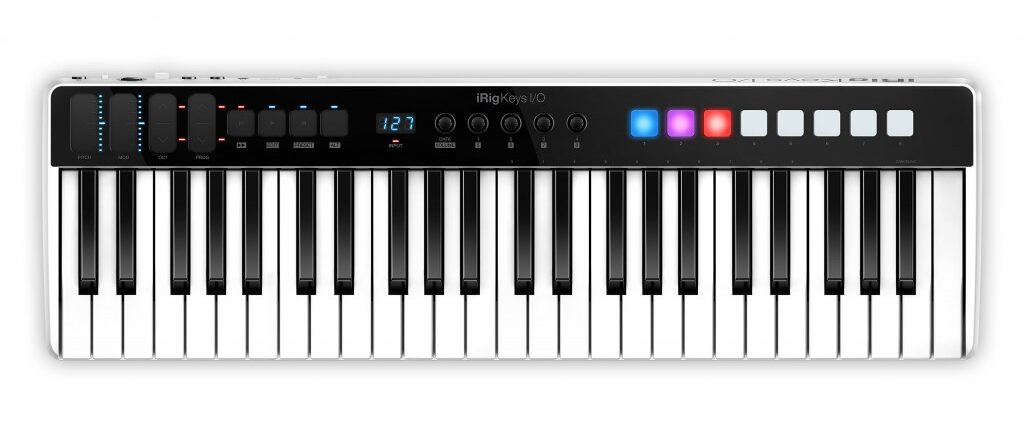
Another IK product that gets used in every single recording I make these days is the iRig Keys I/O 49 midi keyboard controller. I use it to play keyboard, organ and synth parts, as well as a variety of other MIDI triggered sounds and sample libraries.
With software like Sampletank and Kontakt, it’s possible to play an enormous number of different sounds by using a MIDI controller/keyboard. I’ve collected a number of sample libraries over the years that encompass things cinematic pads, orchestral instruments, vintage synth sounds, voices, bass, percussion, full drum kits and even high quality sampled acoustic and electric guitar sounds.
In addition to 49 velocity sensitive keys, the iRig Keys I/O features 5 knobs that can be used to control to 10 instrument and effect parameters, 4, Pitch/Mod sliders, and 8 pads for tapping out beats and other samples. It even has transport buttons, so you can control the Play, Record, Rewind and Stop functions within Logic Pro and GarageBand right form the keyboard.
In addition the iRig Keys has a built-in 24/96kHz audio interface, with a guitar input and an XLR mic input with +48v Phantom Power, and it has both speaker and headphone out jacks.
Designed to be an all-in-one production station for Mac or iOS, the iRig Keys I/O, which comes in either 25 or 49 key models, can function as a self-contained unit for playing live, composing, or even recording multiple instruments.
There are a lot of MIDI keyboards on the market, but I really like the IK Multimedia gear. The iRig Keys I/O not only ticks a lot of boxes, it’s a well designed, quality unit that fosters a lot of musical creativity.
With the 25-key version and either a laptop or an iPad, you would have an incredibly powerful and portable rig.
3. SE Electronics sE2200 Condensor Microphone
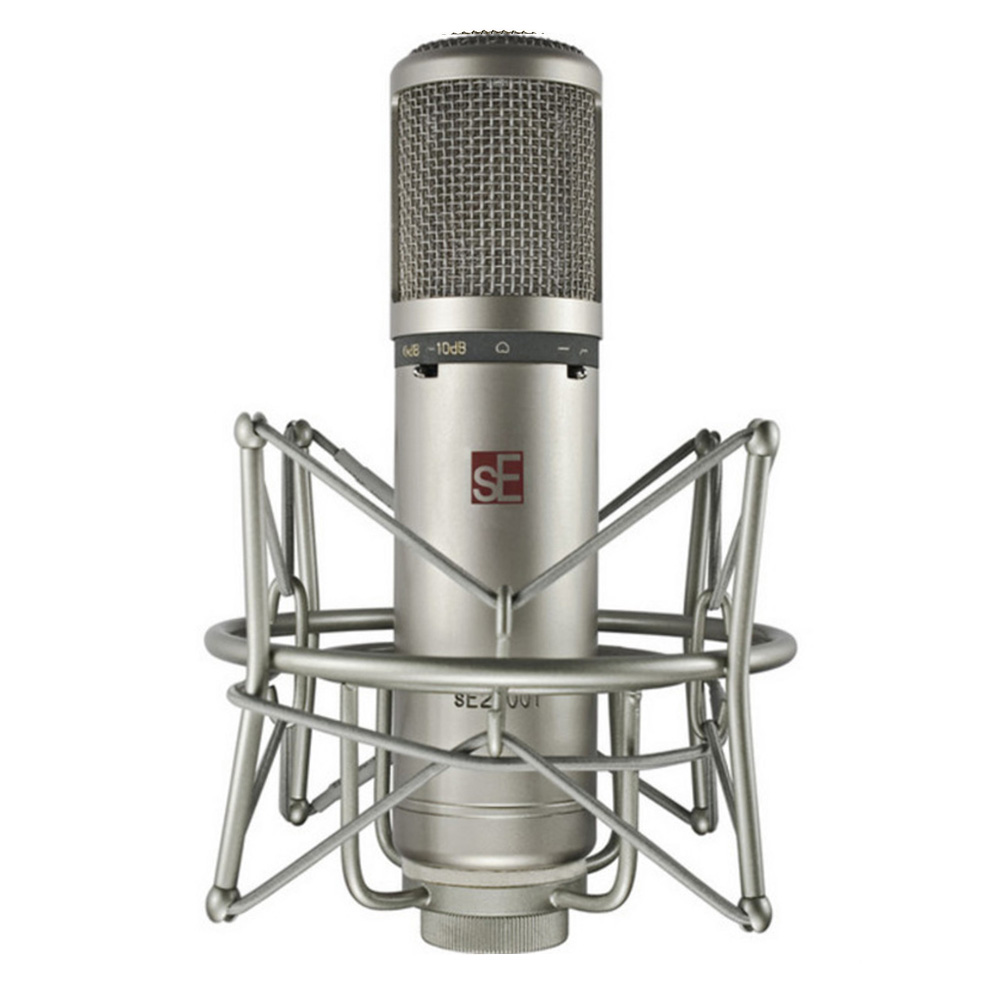
The SE Electronics sE2200 is a high quality large capsule condenser mic that has earned its place as a solid performer in the industry.
Made with a pair of hand-crafted 1-inch gold-sputtered diaphragms and discrete components, this classic design studio mic offers state of the art sound quality and an affordable price tag.
I’ve had my sE2200 for about 20 years, and I’ve used it to record all of my vocal tracks during that time, as well as acoustic guitars, and things like hand claps, percussion and a foot stomp on a brick that I used on a fingerstyle blues piece I did.
It has Class A electronics, excellent audio reproduction, an extremely low noise floor, very high sensitivity, a -10/-20dB pad, Low-Cut filter switch to eliminate rumble and excessive bass, and it a custom transformer that provides a superb level of depth, clarity and sonic characteristic to your recorded sources.
There’s not much else to say about the sE2200. There are a lot of great mics out there that cost a whole lot more money, but the 2200 is and always has been a solid choice. Incredible sound at a reasonable price. A winner all the way.
4. Behringer X-Touch One Control Surface

The newest piece of gear in my arsenal is the Behringer X Touch One Universal Control Surface. With a motorized fader, rotary/pan knob, LED scribble strip, dedicated transport controls, a large jog wheel, and 34 illuminated soft-touch buttons, the X Touch One is a DAW controller lets me control most of my often-used recording tasks with a wonderful, tactile ease.
Essentially, this device lets me get away from having to use the mouse/trackpad for everything. (This is especially useful when recording on laptops.) It makes me feel like I’m actually doing serious recording stuff, instead of just playing on the computer. It makes me feel like I’m working in a legit recording studio, albeit a very tiny one, and it saves me from the awkwardness of trying to play guitar and do computer commands at the same time
Picture me with the guitar in my lap, ready to record a track. I pick up the Wacom stylus, navigate the cursor across the big iMac Pro screen, click the little “Arm Track” button on the right track, then hit record, put down the stylus, grab up the guitar pick out of my mouth, hopefully nail the part, and then pick up the stylus again to hit “stop.”
Imagine doing this tens, or hundreds of times during a project. With the X Touch One, it’s endlessly easier to select the track, hit “record ready,” and press the transport and other track controls with my left hand. Better yet, hook up a footswitch and set that to control the record/punch function.
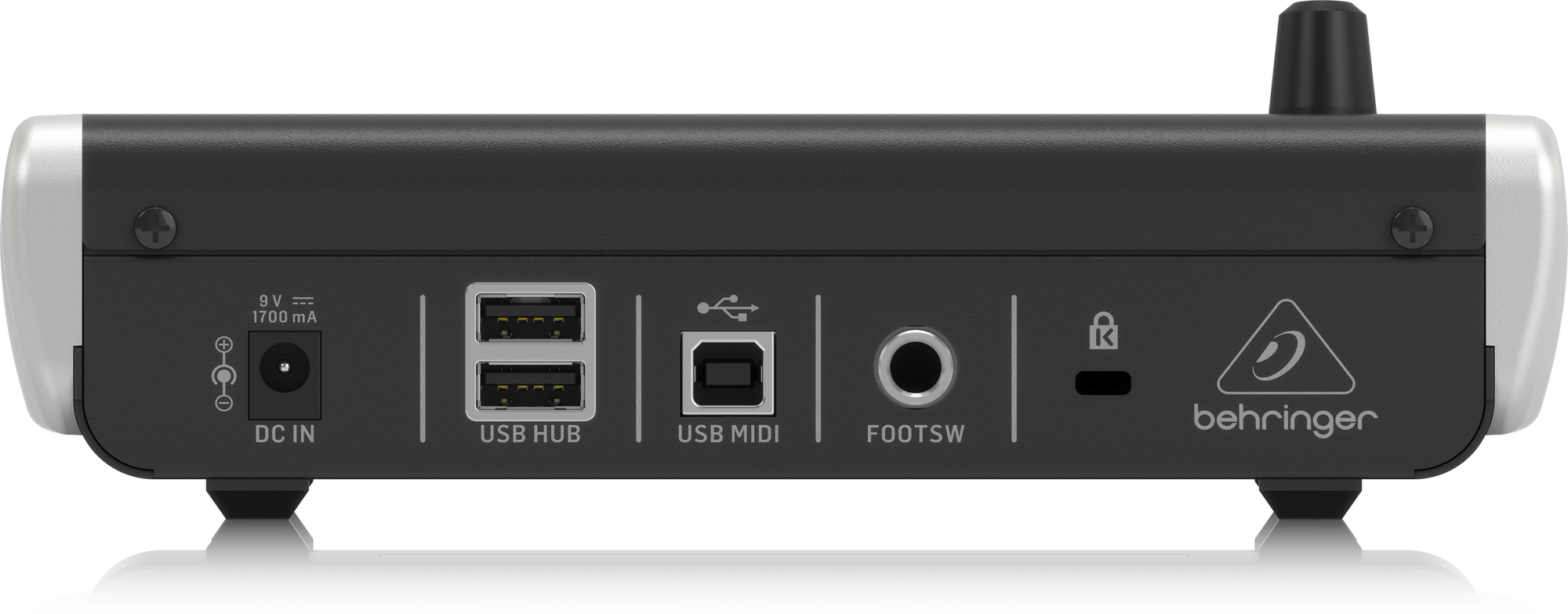
Seriously, I’ve been waiting for a device like this ever since I graduated from music college 30 years ago. Having learned the craft of recording and mixing on large consoles, I’ve long realized that I’ll probably never actually have space in my life for a big studio and a 48 channel desk of my own.
However, this little unit gives me the same feel and comes about as close as I can get, considering how little room I have on my desk.
Utilizing MIDI and the industry standard Mackie Control Protocol, the X Touch One integrates seamlessly with music apps like Logic Pro, Pro Tools, Cubase, Ableton Live, Reaper and others, it lets you control numerous transport, track and automation functions right from the device.
Basically, you can jump through the different tracks in your production and control things like Solo, Mute, Cycle, Nudge, Scrub, Record Enable, Track zoom, Auto Punch and mix automation, one track at a time. The touch sensitive, motorized fader allows you to make precise level and fade adjustments as if you were doing it on a real mixing console. This is so much easier, and way cooler than trying to do it all with the mouse.
Behringer also has a larger 8-fader model of the X-Touch that allows even deeper on-board control of audio and MIDI tracks, as well as EQ, Bus Sends, and Aux Channels. You can also combine multiple X-Touch units, or pair them with the X-Touch Extender and grow your mixing desk to match the size of your real desk.
I’d love to have a full size X-Touch, but for now, the smaller X-Touch One works great and has made my Logic Pro life so much more enjoyable. I can dream, though, right?
5. AKG K371 Studio Headphones
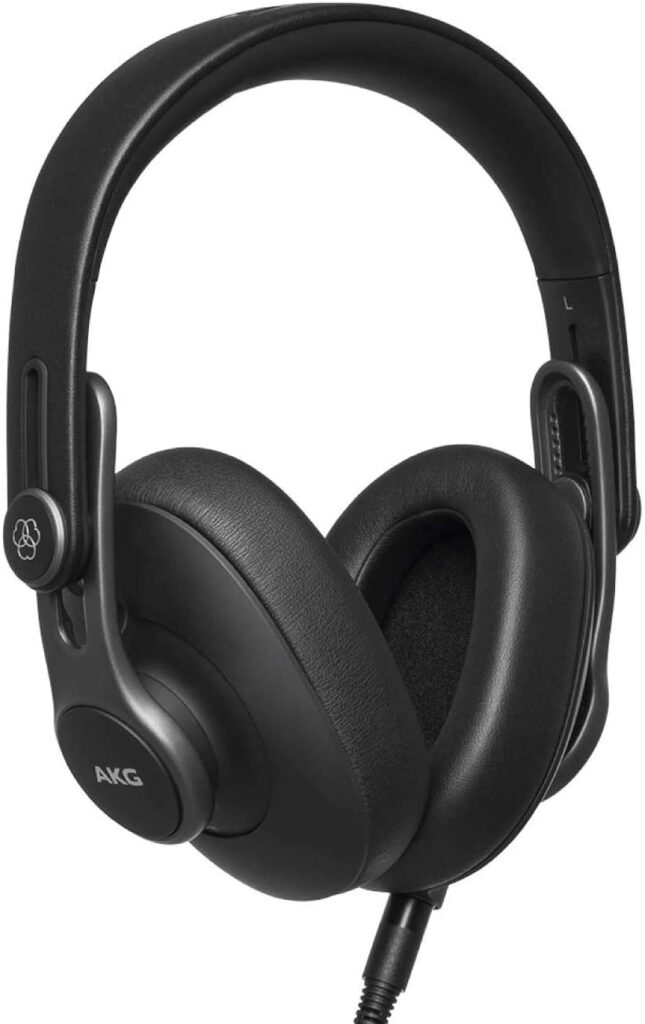
Good headphones are an absolutely essential tool for any music production task. It’s such a no-brainer that I almost didn’t include them on this list.
You can’t really record vocals or acoustic instruments without them, and it’s not like you can crank up your guitar amp to full volume or mix at high SPL levels if you live in a small dwelling and share walls or space with another person.
For about 20 years, I had a pair of Sennheiser eH2200 headphones which I loved. However, they were falling apart, so I finally replaced them this past year. The eH2200s are no longer made, and my local music store didn’t have the Sennheisers I wanted in stock so I got the AKG K371 Studio Headphones instead, and I couldn’t be happier.
Having grown accustomed to the sound of my old Sennheisers, it took a little bit of time to get used to the new frequency response of the AKGs. They’re punchier with more up front midrange and a nice tight bass response, but the sound reproduction and stereo imaging is excellent. I’ve actually found that this brighter response actually works to my advantage when recording and mixing.
My old Sennheisers were a little too forgiving, and so these new cans force me to be more careful and critical with my mixing decisions. (I almost always do my initial mixes on headphones, and then switch back and forth with my studio monitors to tweak the final mix.) I can already tell the difference with my latest songs.
Part of me wants to spend the money and get an even more expensive, dedicated pair of headphones for mixing, but I’ve been pretty happy with my most recent mixes, so I’m having a hard time justifying that purchase.
Overall, the AKG K371 headphones sound great, they’re comfortable when you wear them for hours, and they’re didn’t cost very much money. They’re even on sale right now.

